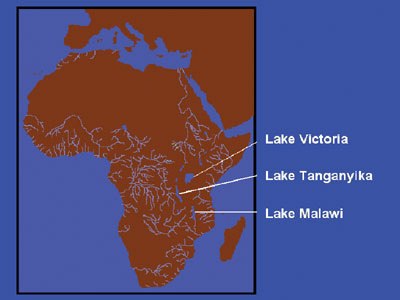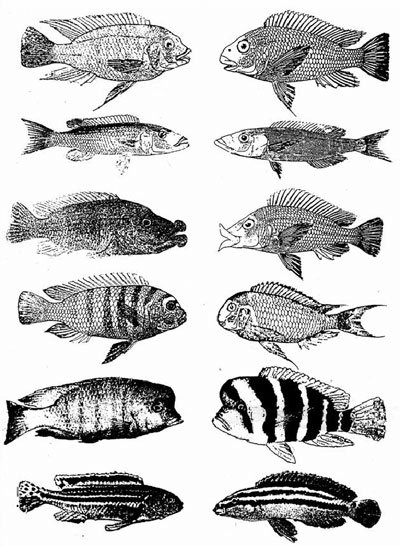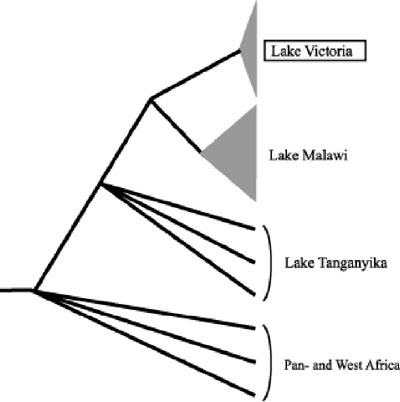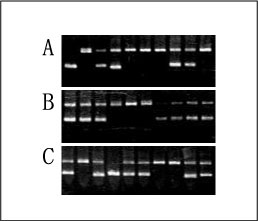| DIVISION OF CELL FUSION (ADJUNCT) | ||||||||
|
||||||||
The above members of this adjunct division have started
a new project in this institute in April 2003. During the long history of evolution of vertebrates, they acquired extensive diversity in characters such as morphology, ecology and behavior. Some examples, such as conserved morphological traits of coelacanths, show that phenotypic change during the course of evolution can be sometimes very slow, whereas other examples suggest, by contrast, that their speciation and diversification can be often accomplished very rapidly by the process called “adaptive radiation”. What factors affect rates of phenotypic change during the evolution of vertebrates? Although many examples of adaptive radiation (and slow evolution) have been reported so far for various groups of vertebrate, its mechanism has been hardly clarified, especially from the molecular perspective. Morphological diversification of organisms is accomplished by differentiation
of developmental systems, which are controlled by regulation of numerous
morphogenetic genes. This implies that, in order to obtain insights
into the mechanisms of adaptive radiation of vertebrates, we absolutely
need the viewpoint of developmental biology. However, the fields of
evolutionary biology and developmental biology have not been necessarily
interactive enough so far in spite of that such an idea has been becoming
popular in recent years. Our division aims to understand the processes
and mechanisms of diversification of vertebrates during their evolution
based on molecular approaches of evolutionary developmental biology
(evo-devo). Cichlid flocks of the East African Great Lakes, which consist of Lakes Victoria, Malawi, and Tanganyika, have attracted the interest of evolutionary biologists for more than a century (Figure 1). These species exhibit extraordinary levels of diversity and high species endemicity to each lake as the result of independent explosive adaptive radiation (Figure 2). Our group conducted phylogenetic analyses of these fish using insertions of retroposons as markers for elucidation of their evolutionary history. These studies confirmed that cichlids in Lakes Victoria and Malawi are closely related, and that species in both lakes are related to only a portion of the lineages found in Lake Tanganyika, the oldest Great Lake estimated at 9-12MY (Figure 3). Evidence from the above analyses suggested that the fauna in Lake Tanganyika as well as its ancestor and other riverine lineages have experienced at least two waves of a rapid radiation event more than several million years ago. Interestingly, such radiations seem now ongoing in the Victorian fauna (see the next section for the detail) and the major groups of cichlids in Lake Malawi, too. These results suggest that explosion of speciation (adaptive radiation) has been a common phenomenon during the course of evolution of cichlids is East Africa. Given the above results, the next primary problem to be solved in
order to clarify the background of their evolution is how their genetic
and developmental systems have changed during the processes of adaptive
radiation.
Among the cichlid faunas in African Great Lakes, the one in Lake Victoria is considered to be the youngest since this lake is suggested to have once been dried up about 12,000 years ago. Such a recent origin of this fauna is consistent with the observation by our group that most of selectively-neutral polymorphic alleles are retained both within- and among species within this lake (Figure 4). This means that, if a certain allele is uniquely fixed at a certain locus in natural populations of a certain species, we can assume the past and/or present existence of a selective pressure on this gene and hence can regard it as a candidate gene that was responsible for the phenotypic differentiation of this species from other related species. Therefore, investigation of cichlids in Lake Victoria is advantageous for the purpose of elucidation of molecular mechanisms of speciation and their following diversification during the adaptive radiation. One of the most attractive diversification of the above cichlids is observed in morphology of jaws. Since they exhibit remarkable specialization to various food resources such as algae, shrimps, fry, planktons and fish, morphology of their jaws shows extensive diversity among species. Another interesting point is that all the cichlids in Lake Victoria, as well as those in Lake Malawi, show mouth brooding of their eggs and fry. Thus, their jaw shape might be also related to their breeding habit. Therefore, the mechanism of diversification of jaw shapes among species may be one of the most important factors to be considered for the present purpose. One of our strategies to identify genes that were responsible for
diversification of jaw shapes among Victorian cichlids is to use transgenic
techniques. For a detailed observation of morphogenesis of jaws, injection
of the GFP (Green Fluorescent Protein) gene with a promoter known
to be specific to this organ may be useful. Another advantage of establishing
a transgenic system is that we can newly identify genes that are specifically
expressed in jaws by using gene-trap and enhancer-trap systems. However,
a problem with application of this methodology to cichlids is that
transgenic techniques have been hardly established for these fish
so far. One solution to this problem is to take advantage of a transposon-mediated
transgenic system, which was recently established for zebrafish and
shown to be highly efficiently integrated into the genome compared
to other conventional systems. In order to apply this transgenic system
to the above cichlid fish, we have started control experiments using
zebrafish.
|
||||||||
| Original papers:: Terai Y, Takahashi K, Nishida M, Sato T, Okada N (2003) Using SINEs to probe ancient explosive speciation: “Hidden” radiation of African cichlids? Mol. Bio. Evol. 20: 924-930. Terai Y, Morikawa N, Kawakami K, Okada N (2003) The complexity of alternative splicing of hagoromo mRNA is increased in an explosively speciated lineage in East African cichlids. Proc. Natl. Acad. Sci. USA 100:12798-12803. Terai Y, Takezaki N, Mayer WE, Tichy H, Takahata N, Klein J, Okada N (2003) Plylogenetic relationships among East African haplochromine fishes as revealed by short interspersed elements (SINEs). J. Mol. Evol. in press. Watanabe M, Kobayashi N, Fujiyama A, Okada N (2003) Construction of a BAC library for Haplochromis chilotes, a cichlid fish from Lake Victoria. Genes Genet Syst 78:103-105. |



